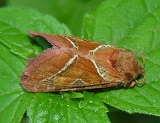
Orange Swift
Encyclopedia
The Orange Swift also known as "Orange Moth" (but see Angerona prunaria
), is a species of moth
belonging to the family Hepialidae
. It was previously placed in the genus Hepialus. It is distributed throughout Europe
.
This species has a wingspan
of 32-48 mm. The male has rich orange forewings with two white bars forming a "v" shape. The hindwings are dark brown. The female is similar but generally larger and less brightly coloured. It flies at night from June to September and is attracted to light.
The larva
feeds on the roots of various plants including bracken
, dandelion, dock
, hop
and Viper's Bugloss
. This species overwinters twice as a larva.
Angerona prunaria
The Orange Moth is a lepidoptera from the family Geometridae, the geometer moths.The moth prefers forest areas and is mostly found in The Netherlands and Belgium.The flight time is May to July....
), is a species of moth
Moth
A moth is an insect closely related to the butterfly, both being of the order Lepidoptera. Moths form the majority of this order; there are thought to be 150,000 to 250,000 different species of moth , with thousands of species yet to be described...
belonging to the family Hepialidae
Hepialidae
The Hepialidae is a family of insects in the lepidopteran order. Moths of this family are often referred to as swift moths or ghost moths.-Taxonomy and systematics:...
. It was previously placed in the genus Hepialus. It is distributed throughout Europe
Europe
Europe is, by convention, one of the world's seven continents. Comprising the westernmost peninsula of Eurasia, Europe is generally 'divided' from Asia to its east by the watershed divides of the Ural and Caucasus Mountains, the Ural River, the Caspian and Black Seas, and the waterways connecting...
.
This species has a wingspan
Wingspan
The wingspan of an airplane or a bird, is the distance from one wingtip to the other wingtip. For example, the Boeing 777 has a wingspan of about ; and a Wandering Albatross caught in 1965 had a wingspan of , the official record for a living bird.The term wingspan, more technically extent, is...
of 32-48 mm. The male has rich orange forewings with two white bars forming a "v" shape. The hindwings are dark brown. The female is similar but generally larger and less brightly coloured. It flies at night from June to September and is attracted to light.
The larva
Larva
A larva is a distinct juvenile form many animals undergo before metamorphosis into adults. Animals with indirect development such as insects, amphibians, or cnidarians typically have a larval phase of their life cycle...
feeds on the roots of various plants including bracken
Bracken
Bracken are several species of large, coarse ferns of the genus Pteridium. Ferns are vascular plants that have alternating generations, large plants that produce spores and small plants that produce sex cells . Brackens are in the family Dennstaedtiaceae, which are noted for their large, highly...
, dandelion, dock
Rumex
The docks and sorrels, genus Rumex L., are a genus of about 200 species of annual, biennial and perennial herbs in the buckwheat family Polygonaceae....
, hop
Hop (plant)
Humulus, Hop, is a small genus of flowering plants native to temperate regions of the Northern Hemisphere. The female flowers of H. lupulus are known as hops, and are used as a culinary flavoring and stabilizer, especially in the brewing of beer...
and Viper's Bugloss
Viper's Bugloss
Echium vulgare is a species of Echium native to most of Europe, and western and central Asia. It is also common in North America....
. This species overwinters twice as a larva.
- The flight season refers to the British IslesBritish IslesThe British Isles are a group of islands off the northwest coast of continental Europe that include the islands of Great Britain and Ireland and over six thousand smaller isles. There are two sovereign states located on the islands: the United Kingdom of Great Britain and Northern Ireland and...
. This may vary in other parts of the range.

